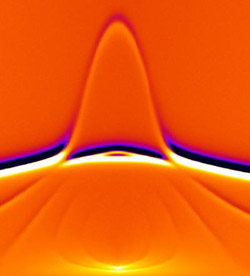Measurements from the edge: magnetic properties of thin films

Spectroscopic image showing the microwave-frequency magnetic resonances of an array of parallel, metallic thin film nanowires ('stripes'). The peak in the center is due to resonances occurring at the stripe edges while the strong horizontal bar is due to resonances in the body of the stripes. Credit: Brian Maranville
Ferromagnetic thin films of metallic materials—ranging in thickness from fractions of a nanometer to several micrometers—are layered in patterns on a substrate (such as silicon) during the manufacture of many microelectronic devices that use magnetic properties, such as computer hard drives.
While methods for measuring the magnetic properties of ferromagnetic thin films have existed for some time, there currently is no way to define those properties for the edges of the film. On a relatively large-scale device, this doesn’t matter much. However, as microelectronic components get smaller and smaller, the edge becomes a bigger and bigger fraction of the surface, eventually becoming the thin film’s dominant surface and the driver of its magnetic character. (Shrink a disk by half and the top surface area is reduced by a factor of four while the length of the edge is only halved.)
A research team from NIST, IBM and MIT recently demonstrated a spectroscopic technique for measuring the magnetic properties of the edges of nickel-iron alloy thin films patterned in an array of parallel nanowires (called “stripes”) atop a silicon disk. The researchers beamed microwaves of different frequencies over the stripes and measured the magnetic resonances that resulted. Because a thin film’s edge resonates differently from its center, the researchers were able to determine which data—and subsequently, which magnetic behaviors—were attributable to the edge.
In its first trials, the new technique has been used to measure how the magnetic properties of the thin film edge are affected by the thickness of the film and the processing conditions during the stripe patterning. Data gained from the study of stripes with widths of 250 to 1,000 nanometers will be used to predict the behavior of similar structures at the nanoscale level (100 nanometers or less).
Media Contact
All latest news from the category: Physics and Astronomy
This area deals with the fundamental laws and building blocks of nature and how they interact, the properties and the behavior of matter, and research into space and time and their structures.
innovations-report provides in-depth reports and articles on subjects such as astrophysics, laser technologies, nuclear, quantum, particle and solid-state physics, nanotechnologies, planetary research and findings (Mars, Venus) and developments related to the Hubble Telescope.
Newest articles

High-energy-density aqueous battery based on halogen multi-electron transfer
Traditional non-aqueous lithium-ion batteries have a high energy density, but their safety is compromised due to the flammable organic electrolytes they utilize. Aqueous batteries use water as the solvent for…

First-ever combined heart pump and pig kidney transplant
…gives new hope to patient with terminal illness. Surgeons at NYU Langone Health performed the first-ever combined mechanical heart pump and gene-edited pig kidney transplant surgery in a 54-year-old woman…

Biophysics: Testing how well biomarkers work
LMU researchers have developed a method to determine how reliably target proteins can be labeled using super-resolution fluorescence microscopy. Modern microscopy techniques make it possible to examine the inner workings…





















